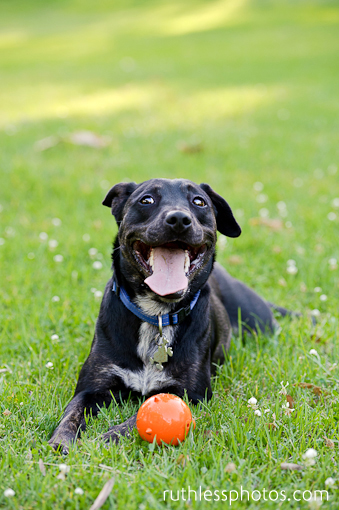Some Thoughts About Dogs welcomes guest blogger Michael D Anderson from NerdWallet.

Photo © Ruthless Photos.
Biologists at the University of Vienna published a study last month about dogs’ temperament in relation to their owners. The study hypothesized that without their owners, dogs would be more likely to view ambiguous events as negative ones. This is a common feature of human cognition – you’ll often hear that depressed people “see the glass as half-empty.”
The abstract of the study is available here.
The Vienna researchers found that, unlike in humans, when presented with ambiguous stimuli, dogs don’t have a negative judgment bias when they’re in distress. This is a jargon-loaded, awkward way of generalizing on the following: These scientists found that, when hungry, dogs don’t become emotional if their owners are absent—they go right to the bowl of food because, following one of the experiment’s stipulations, these dogs hadn’t eaten in at least three hours.
Experimenters measured how long it took each of 24 dogs to approach a bowl—the study had initially included 32 animals, but the scientists decided to exclude dogs that had unusually extreme separation anxiety.
In training—before the two testing days—the biologists conditioned the dogs to identify one side of the testing room as positive—where a bowl had food—and the other side as negative—where a bowl was empty.
On testing days, they refreshed dog’s memories about the room, but then they changed up locations a bit. They established near-negative (i.e. closer to the original negative location), middle and near-positive locations. At the beginning of each test, they approached one of these new locations with a bowl.
The experimenters then tested for “latency,” or long it took the dogs to approach the bowl, when the owner was present and when he or she was absent. The owner, they said, had an effect. The dogs took longer to approach the near-negative location and shorter to approach the near-positive; in tests without the owner, they approached at the same rate to each respective location.
What I don’t understand is how the biologists so tightly connect dogs’ approach to food—which they measure as “latency”—to their mood. The idea, I think, was that dogs should take longer to approach a bowl—even if the location is near-positive—when the owner isn’t there. The idea is that the dog is distressed without the owner around—they’ll start barking, toileting, or whatever else instead of going right to the bowl.
But these dogs were hungry: as I mentioned at the beginning of this piece, owners were asked not to feed their dogs in the 3 hours before the study.
The whole premise of this experiment is odd. What they pose is that dogs are less temperamental than humans: emotional distress or not, they’ll logically discern where the food is. What I think they meant to ask is whether or not dogs behave any different after domestication: Are they still primal? The answer, I think, didn’t even require extensive experiments: yes, they’re hungry, owner be damned.
Further reading:
“Animal Behaviour: Cognitive Bias and Affective State”
“Bias in Interpretation of Ambiguous Sentences Related to Threat in Anxiety”
“Dogs Showing Separation-Related Behavior Exhibit a ‘Pessimistic’ Cognitive Bias”
This article comes from NerdWallet, a consumer-focused, analysis-driven website dedicated to dissecting the data behind the story.
![]() In 1975, a well preserved “dog-like” skull was found in the Razboinichya Cave (in the Altai Mountains in Siberia). Because this skull was so well preserved, it provided opportunities for study between this animal, dogs, and wolves.
In 1975, a well preserved “dog-like” skull was found in the Razboinichya Cave (in the Altai Mountains in Siberia). Because this skull was so well preserved, it provided opportunities for study between this animal, dogs, and wolves.




